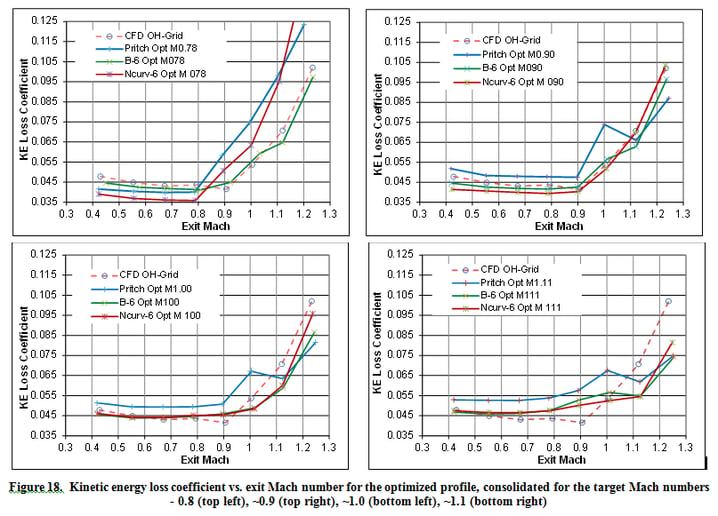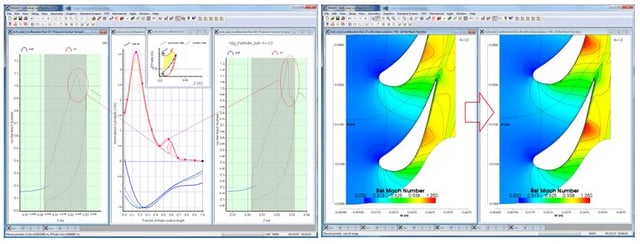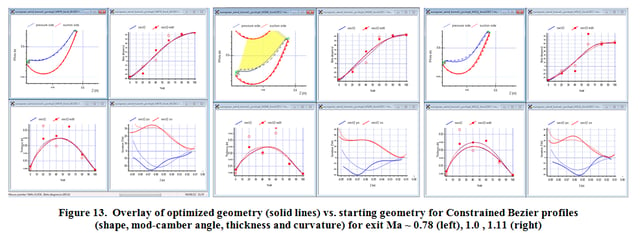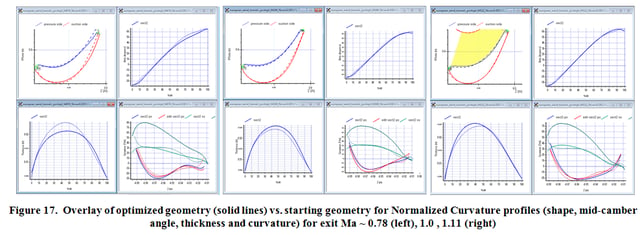The Gyroscopic Effect
This post covers one of the fundamental issues that makes rotordynamics a unique subject: The Gyroscopic Effect. The gyroscopic effect can be observed in the behavior of spinning tops, fidget...
A blog on what's new, notable, and next in turbomachinery
By Oleg Dubitsky
Apr 6, 2017
Arbitrary blade section profiling is an essential part of designing high performance axial turbines and compressors. In most cases such blade section models are formed by hybrid use of arbitrary curves and blade section parameters, such as blade angles, chord, sizing of edges, wedge angles etc. Hybrid blade section models deliver to the design process both convenience and flexibility of controlling section geometry.
However, selecting a specific class and parametrization of the curves restricts the domain of achievable blade section geometries, eliminating from the design space potential geometries that cannot be represented with the allocated curve types. Different curve parametrizations produce similar looking profiles, but different aerodynamic performance.
For example, in an optimization exercise using two-dimensional CFD, reported in Concepts NREC’s presentation in Prague (Turbostroje, September 2013), we compared the ability to reduce profile losses of a convergent nozzle for different target exit Mach numbers (0.8, 0.9.1.0 1.1) using fully parametric Pritchard, arbitrary Bezier and arbitrary curvature controlled blade section models vs a prototype section (Kiock, 1986),:

These results shows the benefit of arbitrary blading (Bezier and Curvature defined), with the optimized curvature based blade section geometry almost universally offering lower losses for each exit Mach number target.
Looking more closely at the blades with normalized curvatures (normalization by camber and chord) in particular, these offer the following benefits vs Bezier and spline-based arbitrary blading:
Naturally hybrid models with combined use of blade parameters (very similar to Pritchard model) and curvature distributions
Independent editing of blade parameters and curvature distributions
Direct local curvature control, which is associated with local aero loading, for intuitive geometry editing. Direct curvature editing during manual or automated optimization also guarantees realistic blade section shapes with non-controversial aero loadings, that helps CFD solver stability for faster design iterations
Reduced parametrization, at least by 2 parameters less per curve vs for polynomial curves of the same order (curvature is defined by the 2nd derivative of a polynomial curve)
Polynomial and spline curvature distribution describe wide classes of curves, including curves with high level continued to discontinued curvature distributions, thus offering wider space of profile candidates vs splines.
Retaining aerodynamic similarity of the modified blade sections by keeping the same normalized curvature distributions
The last property is the basis of reusing profiles, either as scaled versions or as sources of rules to generate modified profiles to fit local flow conditions of specific design projects, with possibility to maintain libraries of reference profiles.
This approach goes in the same direction as one described in (Anders, VKI, 1999-2002), that reports successful practice in reusing curvature distributions to engineer “90%” optimized blade sections using just through flow data and curvature distribution rules of blade sections for quick automated generation of 3D geometries.
The hybrid curvature controlled blade type and a repository of curvature defined sections that can be expanded by user, are available in the AxCent® blade geometry software from Concepts NREC.
The example below from AxCent shows the local relation between curvature distribution and loading distribution by adding “bump” in the normalized curvature distribution:

The optimized Bezier blade shapes vs original profile (matches loss plots above):

The optimized curvature controlled blades profile vs original profile (matches loss plots above):

Tags: CAE Software
By Thomas Gresham, Senior Mechanical Design Engineer
Mar 6, 2024
This post covers one of the fundamental issues that makes rotordynamics a unique subject: The Gyroscopic Effect. The gyroscopic effect can be observed in the behavior of spinning tops, fidget...
By Mark R. Anderson, Chief Technical Officer, Concepts NREC
Jan 10, 2023
Hydrogen is attracting a lot of interest in different circles these days from: propulsion, to energy storage, to personal transportation. The most obvious benefit of hydrogen fuel is a total lack of...
By Dr. David Schowalter, Sr. Director, Global Software Sales
Jan 3, 2023
Because of its promise as a non-polluting fuel, hydrogen is currently a very popular topic among the energy and turbomachinery communities. If hydrogen is reacted with pure oxygen, the thermal energy...